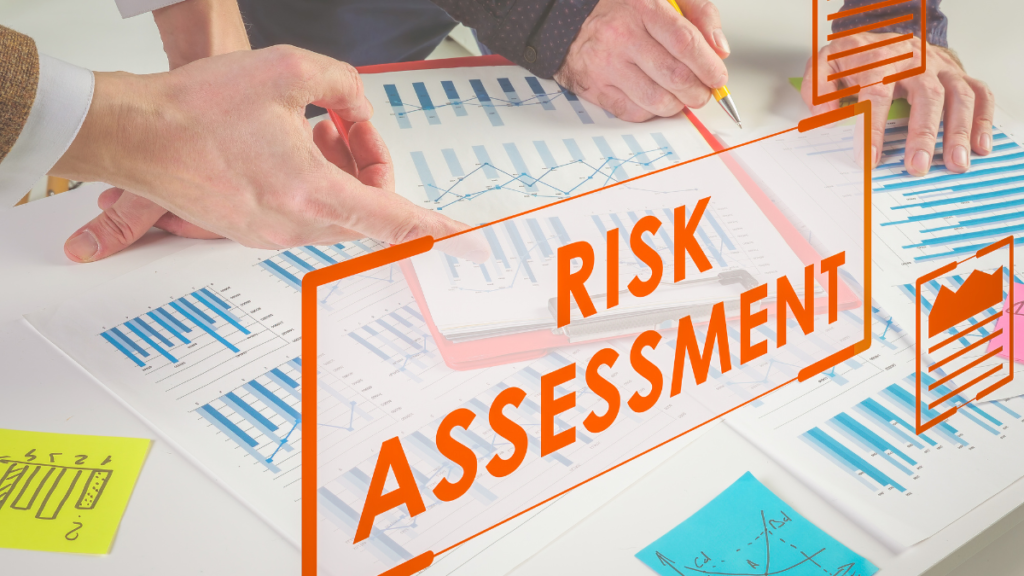5 Steps to Conduct Effective Risk Assessments (Step-by-Step Guide):

What is a Risk Assessment?
A risk assessment is a systematic process of evaluating potential hazards that could cause harm in the workplace.
It involves identifying hazards, assessing the likelihood and severity of harm, and implementing control measures to eliminate or mitigate them.
The goal is to prevent accidents and illnesses by proactively addressing potential hazards.
Step 1: Identify Hazards
The first step in conducting a risk assessment is to identify all potential hazards in the workplace. That simply means looking around your workplace and thinking about what may cause harm.
Hazards can come in many forms, including physical, chemical, biological, ergonomic, and psychosocial. Here’s how you can identify them:
- Examine the Workplace: Conduct regular inspections of the workplace to identify potential hazards. Look at equipment, materials, and work practices.
- Consult Employees: Employees often have valuable insights into potential hazards. Engage with them and encourage them to report any concerns. Vulnerable workers can inform you of hazards relating to their particular requirements.
- Review Past Incidents: Examine records of past accidents, near-misses, and health issues to identify recurring hazards.
Step 2: Assess the Risks
Once you’ve identified the hazards, the next step is to assess the risks associated with each one. Ask yourself: how likely is it that it could harm someone and how serious could it be?
Here are some points to keep in mind:
- Determine Likelihood: Assess how likely it is that the hazard will cause harm. Consider factors such as frequency of exposure and existing control measures.
- Evaluate Severity: Consider the potential impact of the hazard. How severe would the consequences be if harm occurred? Think about both immediate and long-term effects.
- Prioritise Risks: Rank the risks based on their likelihood and severity. This will help you prioritize which hazards to address first.
Step 3: Implement Control Measures
After assessing the risks, the next step is to determine and implement appropriate control measures to reduce the risks so far as reasonably practicable.
The main question you have is: can I get rid of the hazard altogether, and, if not, how can I control the risks so that harm is unlikely?
The hierarchy of control provides a good framework for prioritising elimination, but suggesting the measures to control a hazard that isn’t possible to remove:
- Elimination: Remove the hazard entirely from the workplace if possible.
- Substitution: Replace the hazard with something less dangerous.
- Engineering Controls: Design or modify equipment to reduce exposure to the hazard.
- Administrative Controls: Implement policies, procedures, and training to mitigate risk.
- Personal Protective Equipment (PPE): PPE is always the last resort when implementing the hierarchy of control. Provide PPE to protect employees from residual risks.
Step 4: Record Your Findings
If your company employs five or more people, it must record significant findings, such as:
- Identified Hazards: List all the hazards you’ve identified.
- Risk Assessment: Detail the likelihood and severity of each hazard.
- Control Measures: Describe the measures you’ve implemented to control the risks.
Step 5: Review and Update Controls
Risk assessments are not something that you do once and forget about.
Regular reviews are necessary to ensure that your control measures remain effective and to identify new hazards.
Here’s how to keep your risk assessment up to date:
- Schedule Regular Reviews: Set regular intervals for reviewing your risk assessment.
- Update After Changes: Review and update the assessment whenever there are significant changes in the workplace, such as new equipment, processes, or personnel.
- Learn from Incidents: Update your assessment based on lessons learned from accidents and near-misses.
Training:
For specialised training on how to conduct risk assessments, we offer the NEBOSH HSE Award in Managing Risks and Risk Assessment at Work course.
It’s a one-day, introductory level qualification jointly developed with the health and safety regulator for Great Britain, the Health and Safety Executive. It is structured around the Health and Safety Executive’s approach to controlling the risks caused by workplace hazards.
It helps you develop straightforward, practical health and safety risk management skills so you can go beyond risk assessments, to effectively control the health and safety risks caused by hazards in your workplace.
If you are a Manager or Supervisor, we also offer specific training for you with the IOSH Managing Safely® course. It helps both managers and supervisors with not only the confidence to manage risks and conduct risk assessments, but also provides them with the supporting knowledge to tackle key health and safety issues in their workplace.